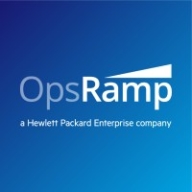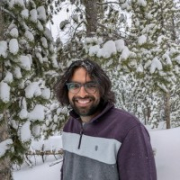

Datadog and OpsRamp are competitors in the IT monitoring and management space. Datadog has a slight edge with its extensive integration capabilities and customizability, while OpsRamp stands out with its AIOps features.
Features: Datadog provides comprehensive monitoring and alerting, excelling in APM, log management, and vast integrations with diverse technologies. It supports root cause analysis and infrastructure monitoring through detailed dashboards and custom metrics. OpsRamp offers event correlation, predictive analysis, and ITSM tool integration, distinguishing itself with AIOps features like automated alerting and a unified infrastructure monitoring interface.
Room for Improvement: Datadog users often request more intuitive navigation, expanded metric options, and improved solution integration. Pricing structure, particularly unexpected costs, is noted as challenging. OpsRamp is critiqued for needing improvements in process automation, report building, and patch management, alongside enhancing its network capabilities and developing a comprehensive CMP tool.
Ease of Deployment and Customer Service: Datadog supports deployment across private, public, hybrid, and on-premises environments, offering extensive resources for ease of deployment. Customer support receives mixed reviews, ranging from highly responsive to inconsistent. OpsRamp generally deploys in public and hybrid clouds, with users noting the need for better performance and support engagement. Both emphasize active support for streamlined deployment processes.
Pricing and ROI: Datadog's high pricing can be a deterrent for smaller organizations, with variable costs posing challenges despite its valued visibility into applications and infrastructure. Users report significant ROI through improved incident response and operational efficiency. OpsRamp is praised for being cost-effective, with pricing based on resource count, offering ROI through enhanced labor efficiency and streamlined monitoring processes.
Previously we had thirteen contractors doing the monitoring for us, which is now reduced to only five.
Datadog has delivered more than its value through reduced downtime, faster recovery, and infrastructure optimization.
I believe features that would provide a lot of time savings, just enabling you to really narrow down and filter the type of frustration or user interaction that you're looking for.
It is important to stick with available features and provide customers with clear, precise details about what can and cannot be done to avoid anomalies.
I find the licensing model convenient and clear enough, and I have seen a return on investment with OpsRamp.
When I have additional questions, the ticket is updated with actual recommendations or suggestions pointing me in the correct direction.
Overall, the entire Datadog comprehensive experience of support, onboarding, getting everything in there, and having a good line of feedback has been exceptional.
I've had a couple instances where I reached out to Datadog's support team, and they have been really super helpful and very kind, even reaching back out after resolving my issues to check if everything's going well.
Having a dedicated firefighter team for each MSP would be beneficial.
Datadog's scalability has been great as it has been able to grow with our needs.
We did, as a trial, engage the AWS integration, and immediately it found all of our AWS resources and presented them to us.
Datadog's scalability is strong; we've continued to significantly grow our software, and there are processes in place to ensure that as new servers, realms, and environments are introduced, we're able to include them all in Datadog without noticing any performance issues.
Datadog is very stable, as there hasn't been any downtime or issues since I've been here, and it's always on time.
Datadog seems stable in my experience without any downtime or reliability issues.
These incidents are related to log service, indexes, and metric capturing issues.
It would be great to see stronger AI-driven anomaly detection and predictive analytics to help identify potential issues before they impact performance.
The documentation is adequate, but team members coming into a project could benefit from more guided, interactive tutorials, ideally leveraging real-world data.
In future updates, I would like to see AI features included in Datadog for monitoring AI spend and usage to make the product more versatile and appealing for the customer.
Technical support should be improved.
The setup cost for Datadog is more than $100.
Everybody wants the agent installed, but we only have so many dollars to spread across, so it's been difficult for me to prioritize who will benefit from Datadog at this time.
My experience with pricing, setup cost, and licensing is that it is really expensive.
it does not strike me as expensive, and the licensing model is clear enough.
Our architecture is written in several languages, and one area where Datadog particularly shines is in providing first-class support for a multitude of programming languages.
Having all that associated analytics helps me in troubleshooting by not having to bounce around to other tools, which saves me a lot of time.
Datadog was able to find the alerts and trigger to notify our team in a very prompt manner before it got worse, allowing us to promptly adjust and remediate the situation in time.
I have utilized OpsRamp's capability for predictive analytics, and it has been important in fostering collaboration between my IT and development teams under DevOps methodologies, where applicable.
| Product | Market Share (%) |
|---|---|
| Datadog | 4.8% |
| OpsRamp | 2.5% |
| Other | 92.7% |


| Company Size | Count |
|---|---|
| Small Business | 80 |
| Midsize Enterprise | 46 |
| Large Enterprise | 95 |
| Company Size | Count |
|---|---|
| Small Business | 1 |
| Midsize Enterprise | 3 |
| Large Enterprise | 8 |
Datadog integrates extensive monitoring solutions with features like customizable dashboards and real-time alerting, supporting efficient system management. Its seamless integration capabilities with tools like AWS and Slack make it a critical part of cloud infrastructure monitoring.
Datadog offers centralized logging and monitoring, making troubleshooting fast and efficient. It facilitates performance tracking in cloud environments such as AWS and Azure, utilizing tools like EC2 and APM for service management. Custom metrics and alerts improve the ability to respond to issues swiftly, while real-time tools enhance system responsiveness. However, users express the need for improved query performance, a more intuitive UI, and increased integration capabilities. Concerns about the pricing model's complexity have led to calls for greater transparency and control, and additional advanced customization options are sought. Datadog's implementation requires attention to these aspects, with enhanced documentation and onboarding recommended to reduce the learning curve.
What are Datadog's Key Features?In industries like finance and technology, Datadog is implemented for its monitoring capabilities across cloud architectures. Its ability to aggregate logs and provide a unified view enhances reliability in environments demanding high performance. By leveraging real-time insights and integration with platforms like AWS and Azure, organizations in these sectors efficiently manage their cloud infrastructures, ensuring optimal performance and proactive issue resolution.
OpsRamp is a leading cloud-based digital IT operations management platform. The solution allows your organization to leverage hybrid observability, process automation, and machine learning to modernize IT operations. OpsRamp can handle the speed, scope, and scale of modern IT and can help you drive productivity and business value. In addition, it can help your business manage, monitor, and consolidate your point tools and applications.
OpsRamp Features
OpsRamp has many valuable key features. Some of the most useful ones include:
OpsRamp Benefits
There are many benefits to implementing OpsRamp. Some of the biggest advantages the solution offers include:
We monitor all IT Infrastructure Monitoring reviews to prevent fraudulent reviews and keep review quality high. We do not post reviews by company employees or direct competitors. We validate each review for authenticity via cross-reference with LinkedIn, and personal follow-up with the reviewer when necessary.